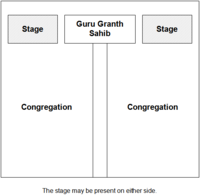
Darbar Sahib
Encyclopedia

Sikh
A Sikh is a follower of Sikhism. It primarily originated in the 15th century in the Punjab region of South Asia. The term "Sikh" has its origin in Sanskrit term शिष्य , meaning "disciple, student" or शिक्ष , meaning "instruction"...
gurdwara
Gurdwara
A Gurdwara , meaning the Gateway to the Guru, is the place of worship for Sikhs, the followers of Sikhism. A Gurdwara can be identified from a distance by tall flagpoles bearing the Nishan Sahib ....
. This hall is where the holy text, current and perpetual Guru of the Sikhs, the Guru Granth Sahib
Guru Granth Sahib
Sri Guru Granth Sahib , or Adi Granth, is the religious text of Sikhism. It is the final and eternal guru of the Sikhs. It is a voluminous text of 1430 angs, compiled and composed during the period of Sikh gurus, from 1469 to 1708...
is placed on a takhat or throne in a prominent central position in the hall.
The Darbar Sahib may also be used to refer explicitly to the inner sanctum of the Harimandir Sahib.
Darbar Sahib - Diwan Hall - Darbar Sahib Worship takes place in the Diwan Hall. (prayer hall). In the diwan hall, there are people playing worship hymns from the guru granth sahib.
All people, visitors and Sikh
Sikh
A Sikh is a follower of Sikhism. It primarily originated in the 15th century in the Punjab region of South Asia. The term "Sikh" has its origin in Sanskrit term शिष्य , meaning "disciple, student" or शिक्ष , meaning "instruction"...
s, who go there every day, have to sit on the floor, cross-legged, because their feet aren't allowed to point towards the Guru Granth Sahib. The Guru Granth Sahib is the living Guru and should be treated with the utmost respect. As The Guru is all-pervading, there is no place where a persons feet are not pointing at The Guru. Nonetheless, it is a sign of respect to sit cross legged. Sitting cross legged is also the traditional and optimal posture for deep meditation
Meditation
Meditation is any form of a family of practices in which practitioners train their minds or self-induce a mode of consciousness to realize some benefit....
. Furthermore, this is an act of equality to all people. Instead of some people standing, some people sitting on chairs and some people sitting on the floor, everybody sits on the floor so nobody is 'higher' than anybody else.
Traditionally, woman and children, and men sit on opposite sides of the diwan hall. This is so nobody is distracted.
The Guru Granth Sahib is placed on pillows, which have 'beautiful cloths' draped over them, which are on a raised platform that has a canopy. The cloths cover the Guru Granth Sahib when it isn't being read. These beautiful cloths are called Romallas.
This is at the front of the diwan hall. Also in the diwan hall, there is another platform where musicians (called the Ragis) sit and play their instruments while the congregation are singing hymns. Music is an important part of sikh worship because it helps when people are singing hymns that are written in the Guru Granth Sahib. The hymns that are written in the Guru Granth Sahib are called Gurbani, which means: The words of the guru.

